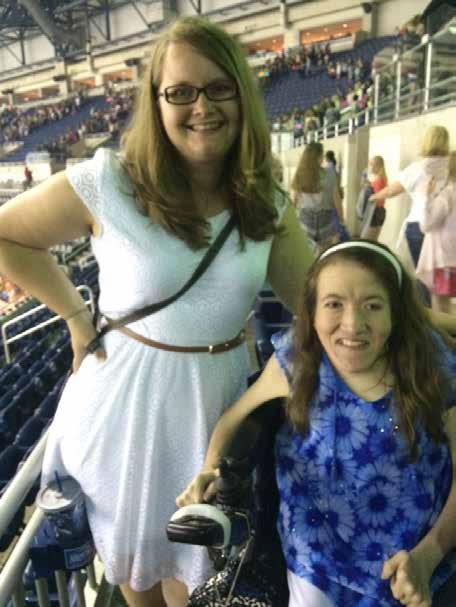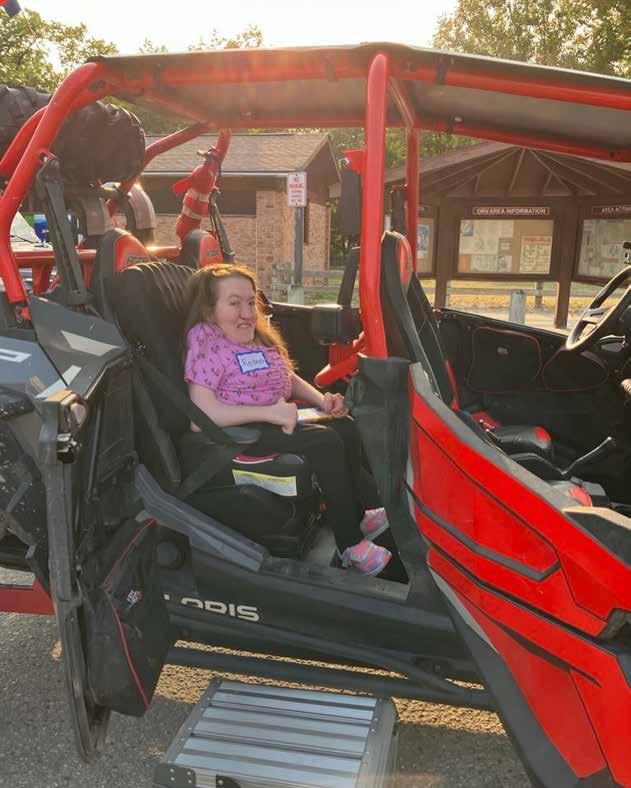
7 minute read
MEET REBECCA PARTEN
A LIFE FULLY LIVED
My Journey with Escobar Syndrome
By Rebecca Parten
When people first meet me, they usually notice my wheelchair before they notice me. But what they don’t see right away is the rich, beautiful life I’ve lived—one filled with love, purpose, and resilience. My name is Rebecca, I’m 35 years old, and I was born with a rare condition called Multiple Pterygium Syndrome, more recently known as Escobar Syndrome.
A Surprise Beginning
My diagnosis was not known during my mom’s pregnancy. It came as a delivery room surprise. I was born small, with webbing across my joints, flexion contractures in all of my joints, rocker bottom feet, and a head full of hair. My doctors immediately knew something was going on, but they couldn’t identify it right away. My mom recalls holding me for just a moment and locking eyes with me—that’s when our lifelong bond was sealed. I was taken to the NICU for observation and testing. Thankfully, I didn’t need breathing support, and after a few days, I went home. One of the first diagnoses suggested was Arthrogryposis Multiplex Congenita (AMC), a broad term that didn’t provide many answers. So, we began the long journey of specialist visits, physical and occupational therapy, and trying to understand what made my little body so different.

At just 11 months old, my parents flew with me tho Seattle Children’s Hospital to see Dr. Judith Hall, a leading expert in AMC. She confirmed within minutes that I had Multiple Pterygium Syndrome, a genetic form of AMC based on physical characteristics. At the time, there were no genetic tests to confirm it—diagnoses were made through observation and exclusion.

Understanding Escobar Syndrome
Escobar Syndrome is a rare genetic condition that is autosomal recessive, meaning both parents must carry the gene mutation. The hallmark features include joint contractures, scoliosis, skin webbing, rocker bottom feet, and sometimes internal organ issues. In my case, the condition primarily affects me externally: I have scoliosis, kyphosis, restrictive lung disease, hearing loss, and low vision, which prevents me from driving. I can walk short distances, but I rely on a power wheelchair most of the time and need help with daily tasks. The rocker bottom feet also affects my every day life in what shoes I can wear and causes pain in the bottom of my feet.

The underlying cause of Escobar Syndrome is believed to involve a malfunction in acetylcholine receptors—the chemicals that send signals from the brain to the muscles. These receptors fail to transition properly in utero, affecting how muscles develop and function. Though researchers have identified specific gene mutations, there’s still much to be discovered, especially regarding why severity varies so much, even among family members.
When I was around 14 or 15, my family participated in a research study overseas. Through a simple blood draw, researchers were able to identify two specific mutations in my case. This exciting discovery not only confirmed my diagnosis at the genetic level but also helped advance testing and potential future treatments.

Growing Up, Going to School, and Advocating for Myself
I’ve always been a determined soul. I started preschool at age 3 in the district’s special education program for kids with physical impairments, receiving services like PT, OT, and adapted gym. After preschool, I transitioned into a general education setting with pull-out therapies, and eventually transferred to our neighborhood elementary school to be closer to home. This was back in the 90s, and I was the first wheelchair user to attend that elementary school. It wasn’t an easy transition for the staff or students, but my family and I helped educate them and open the door for others who came after me. It was during these early years that I began using a power wheelchair, glasses, hearing aids, supplemental oxygen, and a nighttime ventilator due to my scoliosis and restrictive lung disease.
Middle school brought more independence. I had an aide for physical support, but I remained in general education classes. By high school, I advocated to attend classes with minimal support—just accommodations like early dismissal from class to avoid crowded hallways and a study hour in place of gym.

I went on to earn a bachelor’s degree in communications from the University of Michigan–Dearborn while living at home. Later, I pursued a Master of Social Work degree at the University of Michigan–Ann Arbor. It was a major milestone for me to live on campus with the help of caregivers, paratransit, and a strong support system. My parents even stepped in to take overnight caregiving shifts when agencies couldn’t find help—proof of their unwavering support.
Work, Home Life, and Today
Today, I live with my parents, Amy and Jim, and my younger sister Cara, along with our pets—three cats, one dog, and some fish. I work part-time and remotely for the University of Michigan’s Physical Medicine and Rehabilitation Department, focusing on research studies. I love the blend of creativity and purpose it brings to my life—designing flyers, helping with study recruitment, and working on research protocols that will one day improve care for others like me.
While I do experience fatigue and chronic pain, I try to focus on the good. My days are unpredictable—some days I can work for hours, and others I need to lay down and use my ventilator for most of the day. I’ve developed secondary issues over time, like adrenal insufficiency and high blood pressure, which require constant management. But I’ve found joy in the slower pace too—through audiobooks, crafts, and visits from my best friend Danielle and her kiddos.

Challenges and Lessons Learned
Growing up with a rare condition brought many challenges. One of the hardest was undergoing a spinal fusion at just 4 years old because my scoliosis had progressed aggressively. The surgery was long and risky, but necessary to protect my lungs. Thankfully, I only remember the fun stuff—Barney videos and a Barbie McDonalds playset!
Socially, I faced awkward stares and insensitive comments. “What’s wrong with her?” is something I heard more than once. My parents modeled calm, informative responses and taught me to educate rather than get angry. As a kid, I sometimes felt left out, especially watching my sister do things I couldn’t, but my parents always focused on what I could do— and I had some amazing experiences.

Celebrating the Joy
One of my all-time favorite memories is my Make-A-Wish trip to Disney World when I was 6 or 7. Doctors were unsure of my prognosis, so the wish was rushed. Since I wasn’t aware of the fragility of my health, the fact that I got to go within a month of telling my wish-granters what I wanted to do only added to the magic. We met Mickey, visited the beach, and stayed at Give Kids the World Village. For once, people didn’t stare or pity me. They treated me like a princess. The trip allowed my family to just have fun and enjoy being together.
Another special memory is Trails Edge Camp for Ventilator Dependent Children. I attended every summer from age 11 to 20. The camp was staffed by medical professionals and volunteers who made it possible for kids like me to just be kids. Horseback riding, crafts, fishing, a treehouse, and a dance (my favorite!).
Advice to Families on a Similar Journey
If you’re a parent of a child with special needs or someone with a rare diagnosis yourself, here’s my advice: Focus on the good times and the little victories. Don’t ignore the hard moments—acknowledge them, because they’re real—but don’t let them overshadow your story. Build a strong support system. Advocate fiercely. And find joy where you can.
Looking Ahead
While my body may continue to change, I’m not defined by my diagnosis. I am a daughter, sister, researcher, friend, and Disney lover. I live a life filled with deep connections, hardwon victories, and quiet moments of peace. I’ve learned to listen to my body, take things day by day, and celebrate every accomplishment, no matter how small.
I may move through life a little differently, but I’ve found my own rhythm—and it’s a good one.










